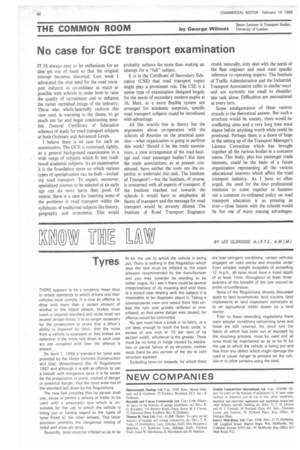'a M
Page 68

If you've noticed an error in this article please click here to report it so we can fix it.
n\ff
Tyres
THERE appears to be a tendency these days to create standards to which drivers and their vehicles must comply. It is now an offence to drive with more than a certain amount of alcohol in the blood stream, brakes must reach a required standard and noise must not exceed certain limits. It is no longer necessary for the prosecution to prove that a driver's ability is impaired by drink, that the noise from a vehicle is excessive or that brakes are defective; if the limits laid down in each case are not complied with then the offence is proved..
On April 1, 1968 a standard for tyres was provided by the Motor Vehicles (Construction and Use) (Amendment) (No 4) Regulations 1967 and although iris still an offence to use a vehicle with dangerous tyres it is far easier for the prosecution to prove, instead of danger or potential danger, that the tyres were not of the standard laid down by the Regulations.
The new law provides that no person shall use, cause or permit a vehicle or trailer to be used with a pneumatic tyre which is unsuitable for the use to which the vehicle is being put or having regard to the types of tyres fitted to the other wheels. This latter provision prohibits the dangerous mixing of radial and cross-ply tyres.
Secondly, tyres must be inflated so as to be fit for the use to which the vehicle is being put. There is nothing in this Regulation which says the tyre must be inflated to the exact pressure recommended by the manufacturer and you may consider its wording to be rather vague. As I see it there could be several interpretations of its meaning and until there is a stated case dealing with the subject it is impossible to be dogmatic about it. Taking a commonsense view one would think that unless the tyre was grossly deflated or over inflated, so that some danger was caused, no offence would be committed.
No tyre must have a break in its fabric, or a cut deep enough to reach the body cords, in excess of one inch or 10 per cent of its section width, whichever is the greater. There must be no lump or bulge caused by separation or partial failure of its structure, neither must there be any portion of the ply or cord structure exposed.
Excluding tyres on mopeds, for which there are less stringent conditions, certain vehicles engaged on road works and tricycles under 2cwt unladen weight incapable of exceeding 12 m.p.h., all tyres must have a tread depth of at least 1mm. throughout at least threequarters of the breadth of the tyre around its entire circumference.
None of the Regulations already discussed apply to land locomotives, land tractors, land implements or land implement conveyors or to an agricultural trailer drawn by a land tractor.
Prior to these amending regulations there were simpler conditions concerning tyres and these are still retained. No recut tyre the fabric of which has been cut or exposed by the recutting process, must be used and all tyres must be maintained so as to be fit for the use to which the vehicle is being put and free from any defect which might damage the road or cause danger to persons on the vehicle or to other persons using the road.


















































































































